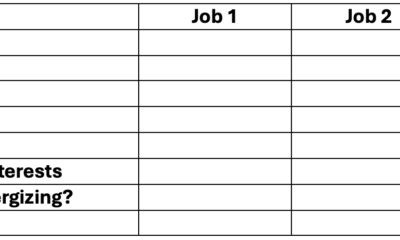Professional Development
5 Bewezen technieken om strategische denkvaardigheden te verbeteren

Developing Strategic Thinking Skills: A Comprehensive Guide
Strategic thinking is one of the most sought-after skills in today’s rapidly evolving business landscape. With market forces accelerating changes at an unprecedented pace, the ability to address ambiguity with a long-term mindset has become crucial for both professionals and organizations.
While developing business strategies may seem intuitive to some, cultivating strategic thinking as a core competency requires investment and practice. Like any profound skill, it needs to be honed over time through self-awareness, questioning, learning, and real-world application.
In this article, we will outline five proven techniques that can help you gradually strengthen your strategic thinking skills. By incorporating these methods into your routine, you will learn to gather and analyze information with greater insight, make objective decisions, and proactively drive organizational change.
Let’s embark on your journey to becoming a strategic thinker and a respected business strategy professional.
Key Aspects of Strategic Thinking
Strategic thinking is a high-level planning approach that considers an organization’s vision, mission, values, strengths, weaknesses, and the internal and external environment in which it operates. At its core, strategic thinking involves understanding an organization’s long-term goals and developing a plan to effectively achieve those goals.
Strategic thinking involves developing a clear vision and mission. The vision provides direction by outlining the organization’s future ambitions. It serves as a guiding star to steer decision-making and resource allocation. The mission describes the overall purpose and objectives that support the realization of the vision. Together, the vision and mission statements give employees a unified sense of purpose and priorities.
Another crucial aspect of strategic thinking is conducting a competitive analysis to understand the market landscape and the organization’s position. A thorough analysis takes into account factors such as target customer base, competitors, available resources, technological trends, economic conditions, and regulations. This external assessment is important for identifying opportunities and threats that can impact objectives. It can also reveal gaps between current capabilities and market requirements.
In addition to external scans, strategic thinkers perform internal assessments. A SWOT analysis (Strengths, Weaknesses, Opportunities, Threats) evaluates the organization’s internal characteristics and capabilities. Strengths reflect core competencies, while weaknesses reveal limiting factors. This inventory is useful for building on positives and addressing negatives. It provides insights for leveraging strengths to seize opportunities and mitigating threats from the external environment.
With a clear sense of direction and self-awareness, strategic thinkers devise strategies that align with their vision. Effective strategies avoid direct competition and instead focus on meaningful differentiation. They also consider adjustments that may be necessary in the long term. Strategies require setting objectives that are specific, measurable, achievable, relevant, and time-bound. Subsequently, critical performance indicators are selected to track progress towards the objectives.
While strategies provide guidance, strategic planning translates ideas into reality through coordinated action plans. Planning maps out goals for initiatives with allocated resources and timelines. It helps test assumptions and ensures that strategies are pragmatic. Regular strategy reviews further support adaptability, allowing adjustments to be made as circumstances change internally or externally.
During implementation, strategic thinking comes to life within the organization. Leaders must articulate the vision with motivation and clarity to gain support at all levels. They foster communication to align individuals behind shared objectives. Also, during implementation, resources and responsibilities are distributed accordingly. Continuous monitoring, troubleshooting, and feedback loops ensure that efforts evolve cohesively towards the vision over time.
5 Techniques to Improve Your Strategic Thinking
Here are five techniques that can help you enhance your strategic thinking and develop a future-oriented mindset:
Technique 1: Pose Thought-Provoking Questions
The first step in strategic thinking is asking insightful questions to unearth key issues, patterns, and perspectives that may not be immediately apparent. Strategic questions delve deeper than superficial inquiries by challenging underlying assumptions. They help uncover opportunities, threats, and ambiguities that prompt new strategic conversations.
- Focus on ‘why,’ ‘how,’ and ‘what if’ questions instead of simplistic ‘what’ and ‘when’ questions. For example, ask: “Why is this issue important?” instead of “what is the issue?”
- Ask direct questions both internally and externally. Explore the capabilities and shortcomings of your organization as well as trends impacting your industry and customers.
- Be curious. Approach every challenge as a learning opportunity, even questioning your own hypotheses and long-held beliefs objectively.
- Share questions, not just answers. Strategic discussions thrive on diverse perspectives, so invite other viewpoints without imposing your own agenda.
Cultivate questioning as a routine practice. Soon, insightful questions will arise spontaneously to advance your strategic thinking.
Technique 2: Reflective Observation
While asking questions uncovers opportunities, understanding them requires reflective observation. Strategic thinkers view challenges through a wide-angle lens and gather diverse perspectives before synthesizing their insights.
The combination of detached introspection and thoughtful consideration of facts leads to intuitive understanding that underpins decisions with significant impact. Some reflective practices include:
- Observe impartially without reacting to surface-level issues. Look beneath superficial problems to discover underlying causes.
- Gather comprehensive data from multiple sources using different lenses. Consider not only numbers but also human aspects like behavior, emotions, and experiences.
- Analyze both tangible and intangible matters. Weigh not only concrete measurement data but also competitive dynamics, industry complexity, and macroeconomic indicators.
- Interpret findings instead of merely reporting them. Identify patterns, link causes to effects, and make hypotheses for future scenarios based on trends.
- Continuously reexamine assumptions in light of new insights. Strategic reflection is an ongoing process, not a one-time event.
Master reflective observation through conscious self-study and journaling. Capture objective analyses of your failures and successes to gain balanced strategic learning outcomes over time.
Technique 3: Consider Contrary Viewpoints
Progressive strategic thinkers actively consider alternative perspectives to challenge their own biases and weaken cognitive prejudices. This helps formulate strategies based on well-rounded thinking rather than limited viewpoints.
Some techniques to embrace different ideas include:
- Play devil’s advocate. Challenge well-reasoned proposals from different angles, just as real skeptics would.
- Conduct internally informed debates. Welcome divergent opinions to expose logical flaws or faulty assumptions in emerging strategies.
- Expand networks beyond comfort zones. Proactively learn from individuals with diverse backgrounds, industries, and countries to broaden strategic frameworks.
- Strategically anticipate criticism. War-game likely objections to strategies in advance from the perspectives of multiple stakeholders and opponents.
- Separate ideas from egos. Take constructive challenges impersonally and be willing to pivot when the benefits of opposing viewpoints become clear.
Seeking contrary viewpoints, however uncomfortable, trains the mind to consider all strategic options comprehensively. It leads to holistic solutions more easily accepted by diverse decision-makers.
Technique 4: Embrace Flexible Frameworks
While clear strategic guidelines provide focus, adept strategists recognize the need for flexibility in uncertain environments. They create inclusive frameworks instead of rigid plans and weave adaptability into strategic thinking processes.
Some ways to build agility include:
- Establish overarching goals rather than prescribed roadmaps. Ambitions with a broader perspective are more resilient to disruptions than incremental routes.
- Develop scenario-based alternatives that are mindful of volatility in the industry and unknown risk factors. Continuously assess trigger points between options.
- Enable decentralized innovation and course correction. Frontline employees closest to the changes understand the emerging reality earliest.
- Encourage holistic thinking instead of isolated thinking. Break down functional barriers to cultivate a shared understanding of business ecosystems.
- Consider planning as an iterative dialogue, not as an annual event. Foster ongoing strategy formation through regular check-ins and recalibrations.
An adaptable mindset makes strategies future-proof against conceptual rigidities. It not only prepares organizations to realize plans but also to flexibly pursue emerging opportunities.
Technique 5: Learn Through Action
Developing strategic thinking is incomplete without experiments in the real world. Applied learning enhances understanding exponentially compared to passive consumption of concepts.
Some impactful ways to learn include:
- Take ownership of live strategic projects and challenges, big or small. Solving hands-on problems enhances practical strategic skills better than merely observing others.
- Iterate continuously based on assumptions through low-cost pilots and MVPs. Rapid testing and learning promote resilience in the face of failures, invaluable for complex initiatives.
- Proactively engage in simulations, case studies, and competitions. Role-playing market dynamics and competition in a safe sandbox sharpens strategic acumen.
- Lead organizational reforms, however incremental. Exposure to change management illustrates strategic leadership beyond theoretical discussions.
- Maintain an implementation diary. Document tactical adjustments, lessons, and developed perspectives from actions to systematically build on experiences.
- Openly share case studies of successes and failures. Transparent storytelling indirectly supports strategic learning among colleagues.
Seeking active practice alongside conceptual mastery anchors strategic skills through multiple reinforcements in the real world. It transforms thinkers into skilled doers.
Final Thoughts
Cultivating strategic thinking requires personal dedication to continuous growth, not just quick fixes. By consistently applying the five techniques discussed, you can gradually embed strategic habits in your subconscious.
To strengthen this journey, focus on collaborative efforts within teams and organizations, fostering a culture that values open dialogue, experimentation, and adaptability. When people collaborate strategically, they create a dynamic environment that fosters shared success and growth.
With patience and passion, you will steadily evolve into a skilled strategic leader, equipped to thrive in today’s VUCA world (Volatile, Uncertain, Complex, and Ambiguous). By remaining committed to expanding your strategic skills, you not only sharpen your abilities but also position yourself for enduring success.
-

 Professional Development1 month ago
Professional Development1 month agoDrawing up your strategy
-

 Personal Growth2 months ago
Personal Growth2 months agoSucceeding as a ‘parentpreneur’: Top tips
-

 Videos2 months ago
Videos2 months agoGreat Leaders INSPIRE Others To Do Great Things
-

 Productivity1 month ago
Productivity1 month agoHow to Increase Remote Work Productivity
-

 Productivity2 months ago
Productivity2 months agoTips for Boosting Work Productivity
-

 Productivity2 months ago
Productivity2 months ago5 Ways to Increase Your Personal Assistant’s Productivity
-

 Leadership1 month ago
Leadership1 month agoHow to Tackle Big Challenges
-
Leadership1 month ago
Cutting Through the Clutter of Internal Communications





















